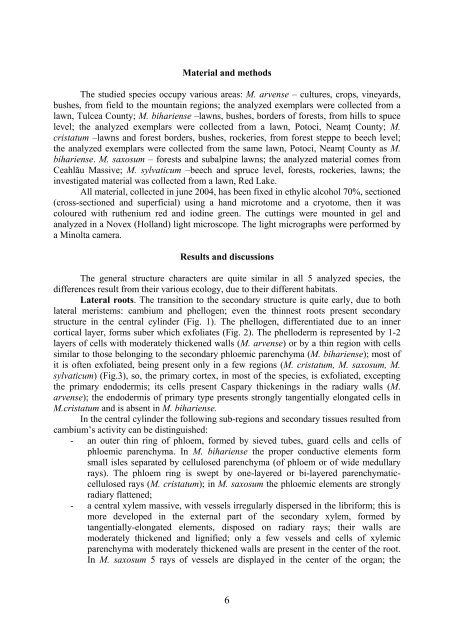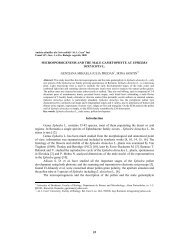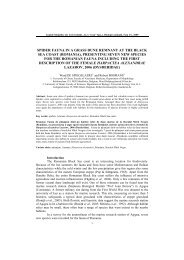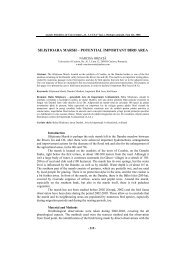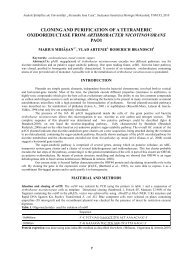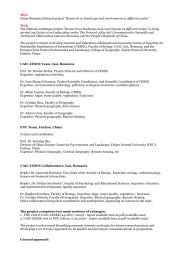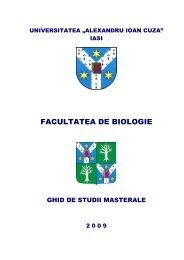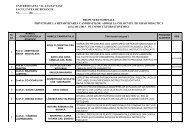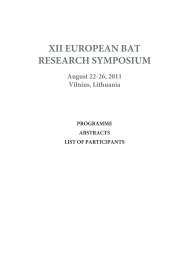Analele ştiinţifice ale Universităţii “Al - Facultatea de Biologie
Analele ştiinţifice ale Universităţii “Al - Facultatea de Biologie
Analele ştiinţifice ale Universităţii “Al - Facultatea de Biologie
You also want an ePaper? Increase the reach of your titles
YUMPU automatically turns print PDFs into web optimized ePapers that Google loves.
Material and methods<br />
The studied species occupy various areas: M. arvense – cultures, crops, vineyards,<br />
bushes, from field to the mountain regions; the analyzed exemplars were collected from a<br />
lawn, Tulcea County; M. bihariense –lawns, bushes, bor<strong>de</strong>rs of forests, from hills to spuce<br />
level; the analyzed exemplars were collected from a lawn, Potoci, Neamţ County; M.<br />
cristatum –lawns and forest bor<strong>de</strong>rs, bushes, rockeries, from forest steppe to beech level;<br />
the analyzed exemplars were collected from the same lawn, Potoci, Neamţ County as M.<br />
bihariense. M. saxosum – forests and subalpine lawns; the analyzed material comes from<br />
Ceahlău Massive; M. sylvaticum –beech and spruce level, forests, rockeries, lawns; the<br />
investigated material was collected from a lawn, Red Lake.<br />
All material, collected in june 2004, has been fixed in ethylic alcohol 70%, sectioned<br />
(cross-sectioned and superficial) using a hand microtome and a cryotome, then it was<br />
coloured with ruthenium red and iodine green. The cuttings were mounted in gel and<br />
analyzed in a Novex (Holland) light microscope. The light micrographs were performed by<br />
a Minolta camera.<br />
Results and discussions<br />
The general structure characters are quite similar in all 5 analyzed species, the<br />
differences result from their various ecology, due to their different habitats.<br />
Lateral roots. The transition to the secondary structure is quite early, due to both<br />
lateral meristems: cambium and phellogen; even the thinnest roots present secondary<br />
structure in the central cylin<strong>de</strong>r (Fig. 1). The phellogen, differentiated due to an inner<br />
cortical layer, forms suber which exfoliates (Fig. 2). The phello<strong>de</strong>rm is represented by 1-2<br />
layers of cells with mo<strong>de</strong>rately thickened walls (M. arvense) or by a thin region with cells<br />
similar to those belonging to the secondary phloemic parenchyma (M. bihariense); most of<br />
it is often exfoliated, being present only in a few regions (M. cristatum, M. saxosum, M.<br />
sylvaticum) (Fig.3), so, the primary cortex, in most of the species, is exfoliated, excepting<br />
the primary endo<strong>de</strong>rmis; its cells present Caspary thickenings in the radiary walls (M.<br />
arvense); the endo<strong>de</strong>rmis of primary type presents strongly tangentially elongated cells in<br />
M.cristatum and is absent in M. bihariense.<br />
In the central cylin<strong>de</strong>r the following sub-regions and secondary tissues resulted from<br />
cambium’s activity can be distinguished:<br />
- an outer thin ring of phloem, formed by sieved tubes, guard cells and cells of<br />
phloemic parenchyma. In M. bihariense the proper conductive elements form<br />
small isles separated by cellulosed parenchyma (of phloem or of wi<strong>de</strong> medullary<br />
rays). The phloem ring is swept by one-layered or bi-layered parenchymaticcellulosed<br />
rays (M. cristatum); in M. saxosum the phloemic elements are strongly<br />
radiary flattened;<br />
- a central xylem massive, with vessels irregularly dispersed in the libriform; this is<br />
more <strong>de</strong>veloped in the external part of the secondary xylem, formed by<br />
tangentially-elongated elements, disposed on radiary rays; their walls are<br />
mo<strong>de</strong>rately thickened and lignified; only a few vessels and cells of xylemic<br />
parenchyma with mo<strong>de</strong>rately thickened walls are present in the center of the root.<br />
In M. saxosum 5 rays of vessels are displayed in the center of the organ; the<br />
6


